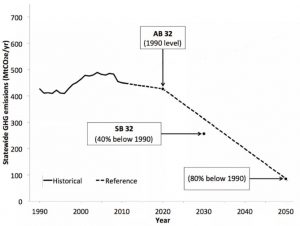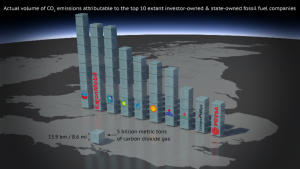October 3, 2016 – Volume 18 #6
In This Issue
Flanigan’s Eco-Logic
First American Offshore Wind
Biophilic Design
CA Climate Leadership Continues
California’s Cap and Trade
Rick Heede and the Carbon Majors
Cities Going 100% Renewable
What’s Up at EcoMotion?
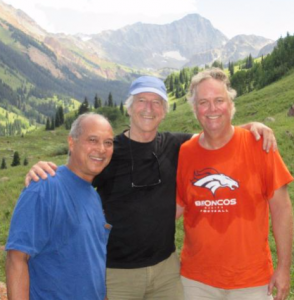
Flanigan‘s Eco-Logic: Hiking Colorado’s Maroon Bells
Michael Totten, Chris Tribble, and I have done trips for decades, there’s a special chemistry that fills our souls. This time it’s hiking in the Maroon Bells near Aspen, Colorado. We travel, rap and relate, laugh, aspire, and inspire. These friendships flourish with adventure, yours too no doubt.
Capital Lake
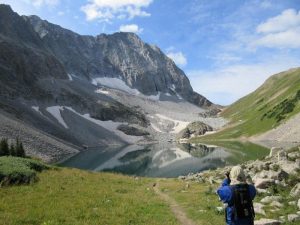 This summer it’s backpacking to Capitol Lake (11,580 feet), an absolutely idyllic high alpine lake in the Bells. We begin at about 9,000 feet, looking south and up the Capitol Creek valley. It is post-card perfect. The lake is at the base of the notorious, 14,137-foot Capital Peak. It rises high above us, known for its infamous “knife-edge”… a narrow strip on the ridge that one has to traverse to summit.
This summer it’s backpacking to Capitol Lake (11,580 feet), an absolutely idyllic high alpine lake in the Bells. We begin at about 9,000 feet, looking south and up the Capitol Creek valley. It is post-card perfect. The lake is at the base of the notorious, 14,137-foot Capital Peak. It rises high above us, known for its infamous “knife-edge”… a narrow strip on the ridge that one has to traverse to summit.
Summits we did not, but we log 31 miles of hiking, all over 9,000 feet, in five days. My sea level training was inadequate. We were in the presence of many of Colorado’s esteemed “fourteeners” of which there are 53 in Colorado. Thanks to Michael and Chris for the main trek, Austin for setting the pace for round two, Bill and Kathy for jumping in for round three and to totally wipe me out, to fulfill my summer alpine trekking.
Gorgeous Rockies they are indeed, marked by sharp rocky peaks, snow fields and crevasses, the bluest of blue skies, aspen trees, rushing streams, pine trees in north-facing valleys. We drive to the trailhead in Old Snowmass, then don our packs for the eight-mile, 2,750-foot ascent to the lake. We pass through forests of shimmering aspens and huff and puff up steep hillsides of berry bushes, crossing the rushing creek several times. The trail rises again and again, we gasp for air and pull hard at our shoulder straps. Within hours we are far from civilization. This is not Los Angeles.
At last we get to Capitol Lake. We look back and admire the valley from on high. What great satisfaction. It’s late afternoon… the lake is nestled below the massive Capital Peak. Precious late sunshine highlights the mountain-tops facing west. We’re whooped, the altitude beating us. We make camp and skip dinner. Late at night it’s so clear to me… that the effort to get out in the wilderness – far from cell coverage and the barrage of media – is so worth it. The feeling is profound. Unplugged.
The next day we revel in the solace and scenic beauty of Capitol Lake. Some campers have left early to summit the Peak. It’s just us in this majestic cirque. How can this place be our own? It’s spectacular beyond words. The water is cold and clear and a rich blue-green in color. There’s nobody here. No cell coverage. Nothing but man in nature in the presence of massive peaks and valleys. Huge clouds punctuate the sky.
Chris fishes; I read. The rainbow trout are jumping and he catches dinner. We head back to camp, light rain becomes heavy rain, then hail, slush, and snow… mountain weather. There’s a saying in Colorado that if you don’t like the weather, wait five minutes. We take cover in our tents, and in a couple hours the storm passes, then the sun shines bright. We spend the rest of daylight drying out.
Lost Man Loop
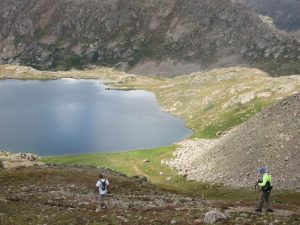 Chris’s son Auston joins us for the next hike to Lost Man Loop. It’s is one of Aspen’s most special day hikes. It begins high up Independence Pass at about 10,000 feet. There we leave car and climb for 2.5 miles to hit the ridge of Lost Man Pass at 12,800 feet. The highest alpine meadows, passing shimmering lakes, and mountainsides dusted with snow. Over the pass, we switchback down to Lost Man Lake. There we sit on rocks at its shores, again all alone in nature’s great majesty, the sun radiating and reflecting off the rippled waters. A breeze cools us; clouds billow above.
Chris’s son Auston joins us for the next hike to Lost Man Loop. It’s is one of Aspen’s most special day hikes. It begins high up Independence Pass at about 10,000 feet. There we leave car and climb for 2.5 miles to hit the ridge of Lost Man Pass at 12,800 feet. The highest alpine meadows, passing shimmering lakes, and mountainsides dusted with snow. Over the pass, we switchback down to Lost Man Lake. There we sit on rocks at its shores, again all alone in nature’s great majesty, the sun radiating and reflecting off the rippled waters. A breeze cools us; clouds billow above.
Visiting RMI and Amory Lovins
 We’re resting our bones in the Roaring Fork Valley! Six stiff legs, all sorts of sore muscles. Someone said something about his feet. A day off from hiking, and we’re in the Versatile studio recording a podcast. Chris does a two-camera shoot. Lights, cameras, action. I interview; Michael Totten explains his current work with Jeremy Rifkin in Luxemburg. The interview gets personal: “Just what it is that keeps you motivated and so focused on our future?” Afterwards, its time for Glenwood’s classic vapor caves.
We’re resting our bones in the Roaring Fork Valley! Six stiff legs, all sorts of sore muscles. Someone said something about his feet. A day off from hiking, and we’re in the Versatile studio recording a podcast. Chris does a two-camera shoot. Lights, cameras, action. I interview; Michael Totten explains his current work with Jeremy Rifkin in Luxemburg. The interview gets personal: “Just what it is that keeps you motivated and so focused on our future?” Afterwards, its time for Glenwood’s classic vapor caves.
We stop by the new Rocky Mountain Institute (RMI) headquarters in Basalt to visit Amory Lovins, its founder and chief, one of my most influential mentors. As we pull up to the new headquarters, I flash back to 1987 and the beginnings. RMI has come a long way. Amory’s at his standing desk, deep in sources and thoughts collected on three monitors. We reminisce, catch up, take photos. He’s proud. We talk flexible LEDs, chairs that cool, the building’s solar and tilt angles, storage and batteries’ demand limiting/rate tariff optimization. The new building is bright and fresh, a great meeting space with break-out rooms. Staff congregates with pleasant chatter in the kitchen. Bikes out front, and as if planted, a young lady softly strums her guitar on the patio.
It was RMI where my mind was blown in the most positive way. Each of us has the power to make a huge difference. Amory catalyzed my understanding of potentials. He showed me the great value of convincing arguments with detailed analyses to back them up. So many great memories… from the first lighting “monologue” that detailed the potential for 91% savings of all U.S. lighting energy at a negative net marginal cost, to the original headquarters and its pair of un-caged iguanas, to visiting with Gorbachev in the Kremlin thanks to Hal Harvey. So many lasting friendships: Sardo, Michael Shepard, Rick Heede, Pat Kiernan, Laura Maggos, Bartlett, Dave Houghton, June Weintraub… all still in my life.
One of our favorite interns at RMI during my tenure was Dave Bill, an Alaskan fisherman of some note who was drawn to RMI. He said listening to Amory Lovins speak is like drinking from a fire hose. And he wanted that, and got it, as did we all. Amory’s wit is endless; he’s got a lot to say about the soft energy path. And we were, and all continue to be on his path of hard work, impacting the planet. Amory liked to say that we were saving the world, having fun, and making money… in that order.
Cathedral Lake
Brother Bill, his wife Kathy, and I head to Cathedral Lake, elevation 11,000 feet for the final hike of the trip. I’d been up to Cathedral a few times before, once backpacking with my 10-year old daughter Sierra. We got caught in an early snowstorm, howling winds below a frigid peak, six inches of snow blanketing our tent. It was quite scary for us. The tent held up; North Face bags are worth the money! By late morning the storm had passed, leaving us in a winter wonderland, a blinding bowl of bright sunshine and warmth. Sierra was especially proud of her mountaineering accomplishment as we trekked out and passed day hikers up to see the first snow of winter.
Sure, I’d had a week of high altitude, but I am still short of breath as we rise high above the Castle Creek Valley floor. I move slowly while Billy and Kathy bound up the trail, chatting easily with other hikers. I catch up and find them with Aspen-area local and musician John Oates – of Hall and Oates. Bill is in the sound business; John talks touring, his new home in Nashville. I’m happy for the break.
Cathedral Lake is another gem. Rocks and snowfields surround the lake. Its water is pristine and frigid. To the north and high above us is Electric Pass, known for its dangerous lightening. After lunch and a fast downhill pace, we drop down to Castle Creek near the Pine Creek Cookhouse.
Back to Reality
I’m conscious that this is my last mile, that my transition from hiking the Rockies and back into “reality” is beginning, my hiking trip coming to its close. We ease down the valley to Highway 82, hanging left and leaving the peace of the mountains. With each thousand feet, I sense this dropping into reality, leaving the mountains, legs sore and yet with a satisfied soul.
The next day Michael and I drive to Denver. Too soon I’m at Denver International Airport (DIA) in a sea of travellers… far from the remote, alpine glory, peace, and splendor of the Colorado Rockies, far from the buds that made my week so special. Far, but I’m holding on to that mountain charge!

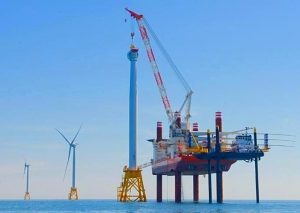
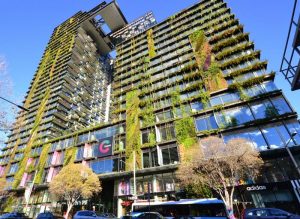
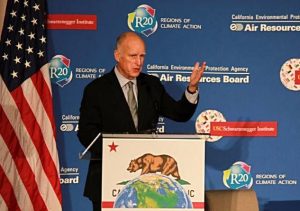 On September 8th, the California legislature made international headlines by passing California Senate Bill 32. The bill, sponsored by State Senator Fran Pavley, solidifies California as the world leader on climate protection. It’s an extension of AB 32 – also sponsored by then Assemblyman Pavley, the Global Warming Solutions Act of 2006. That legislation called for a return to 1990 greenhouse gas emissions levels. SB 32 is much more aggressive, calling for reducing GHGs to 40% below 1990 levels by 2030.
On September 8th, the California legislature made international headlines by passing California Senate Bill 32. The bill, sponsored by State Senator Fran Pavley, solidifies California as the world leader on climate protection. It’s an extension of AB 32 – also sponsored by then Assemblyman Pavley, the Global Warming Solutions Act of 2006. That legislation called for a return to 1990 greenhouse gas emissions levels. SB 32 is much more aggressive, calling for reducing GHGs to 40% below 1990 levels by 2030.